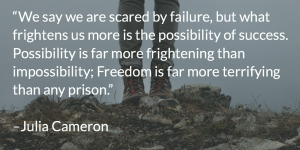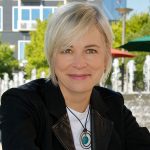
On Knowing When

For years, I’ve observed athletes, politicians, corporate executives, and colleagues maneuver through their careers advancing, transitioning, or retiring. I’ve admired those who always seemed to know when to make a change, and I’ve often felt frustrated by those who didn’t.
There are those who ride the wave until it crests. They stay in a job, continuing in a role that fits, delivering a great impact and return on their unique investment of creative talent. Then, with the same finesse with which they rode that wave, they ride smoothly to the next wave or opportunity. No matter where they are, their presence and leadership imbues their organizations with energy, enthusiasm, and inspiration – during their tenure and after.
Then there are those who never seem to “know when.” They advance and develop, making great contributions to their enterprise and the people it serves. Some receive numerous accolades for their achievements. Five years pass, then 10, 20, and even beyond, and they stay put. I know that a rare few can continue at the top of their game for extended periods, approaching their work with as much fresh energy, passion, and creativity as ever before. More often than not, however, this isn’t the case.
Staying in one spot for too long leaves them comfortable yet stale, feeling burned out and empty. Their flame went out years ago, and because they don’t “know when” – or more likely they do “know” but hold themselves back with fear and doubt – they engender that same lassitude within their environment and culture.
Over my 20 year career, I’ve always wondered, “How do those who know when, know when?”
It was 2008, and I was in my fifth year as President & CEO of the United Arts Council of Greater Greensboro and my twelfth with the organization overall. I found myself experiencing a sense of restlessness. When I first noticed it, I had no idea what it was or what was causing it; I had never felt anything quite like it before. I knew that above all else, it was persistent. I tried ignoring the sensation, passing it off as a nagging ache and drowning it with my work priorities and busy schedule. But it was like a kid sister continuously tapping on my shoulder.
So, I decided to stop fighting it and instead tuned in to it. I would lie awake at night, tossing and turning, and ask, “What is it? What are you trying to tell me?” I would go for a run, and as the day’s stress melted and my mind freed, I wondered: “Is it something to do with my family? My spouse? Work?” And on it went in my day-to-day activities and thoughts over several months. I’d query, wait, and try to listen.
I wish I could tell you that I had a clear and direct sense of “knowing when” (and knowing what), but it was more a steady growing awareness. Things would happen like meeting new people, having an unexpected outcome with a project, and seeing barriers spring up in one place while opportunities grew in another. Small shifts and events I originally thought to be unrelated and random, when considered in aggregate, were actually pointing me toward a new course.
Accompanying this emotional journey was a more tangible recognition that I had accomplished the major goals I had hoped to achieve for the United Arts Council: debt elimination, significant revenue growth, re-focusing of organizational priorities, creating a new business model, and shoring up board and staff leadership.
Eventually, the two paths intersected, and it became quite clear. I knew what. I knew when. And when was now.
I felt satisfied that I had completed what I had set out to do for the organization. Over those twelve years, I had offered my very best in leadership and service to the organization and its greater mission. The professional experience of leading the organization and its people was the highlight of my career to that point. It simply was time to depart and transition into what would come next…at that point, I had no idea what that would be. But I knew one thing for certain: I didn’t want to follow a traditional career path, moving on to lead another nonprofit arts organization.
 After much reflection and consultation with mentors and a career coach, I determined that the right course for me was to complete my tenure at the Arts Council and then take some time off. Clear my head. Explore some creative pursuits. And allow myself the space and time to renew my energy and shape what would come next. So I committed to a year-long sabbatical, and that journey began in December 2009.
After much reflection and consultation with mentors and a career coach, I determined that the right course for me was to complete my tenure at the Arts Council and then take some time off. Clear my head. Explore some creative pursuits. And allow myself the space and time to renew my energy and shape what would come next. So I committed to a year-long sabbatical, and that journey began in December 2009.
During my sabbatical, I came to believe it’s less about truly “knowing” and more about the courage to tune in to that “knowing,” trust it, and follow it. What prevents most from taking the leap is fear – a doubt in one’s own “personal capital” and self-worth.
Author Julia Cameron, in her book Artist’s Way, wrote that: “We say we are scared by failure, but what frightens us more is the possibility of success. Possibility is far more frightening than impossibility; Freedom is far more terrifying than any prison.”
After spending many years in a particular career or post, it’s easy to slip into the mindset of feeling trapped, but secure. You’re good at what you do, you’ve done it for a long time, and you’re compensated well. It’s natural to want to avoid stirring things up. Change will be challenging, most likely require making tough decisions, moving out of your comfort zone, learning something new, or even beginning a new venture. It’s easier to stick it out – you reason – despite your energy having fallen flat and your passion dimmed.
Possibility, potential, and capacity – tapping into those requires taking a leap of faith. I do recognize that deciding to tune in and take action on “knowing when” requires attention to many variables – timing, financial, family, etc. – all of which have to be considered. But jumping into the unknown is the only way we grow, develop, and realize our potential. If we don’t leap, we’ll never know what could be, or how much happier and more fulfilled we could be.
I am convinced that somewhere along the career track, everyone will experience this sense of “knowing when.” When you do, tune in to it, and take action on your instincts.
- Pay attention to the signs. When you sense burnout, boredom, or restlessness within yourself, move toward it, not away from it. Question why you have these feelings and what you could do to restore enthusiasm, energy, and passion.
- Consult with mentors, advisors, or a coach. An outside-in perspective offers an invaluable process of reflection, goal setting, and charting a course.
- Trust in yourself. If you don’t, no one else will. Inventory your greatest attributes and skills; consider these your key leverage points.
- Take action. If you don’t, how will you ever know “what could have been?” Making a significant change can seem overwhelming. Take the big picture and break it down into smaller pieces. Outline actions to take for each that will advance you closer to your ultimate goal.
 About Jeanie Duncan: Jeanie is President of Raven Consulting Group, a business she founded that focuses on organizational change and leadership development in the nonprofit sector. She is a senior consultant for Raffa, a national firm working with nonprofit clients to lead efforts in sustainability and succession planning, executive transition and search. Additionally, Jeanie serves as adjunct faculty for the Center for Creative Leadership, a top-ranked, global provider of executive leadership education.
About Jeanie Duncan: Jeanie is President of Raven Consulting Group, a business she founded that focuses on organizational change and leadership development in the nonprofit sector. She is a senior consultant for Raffa, a national firm working with nonprofit clients to lead efforts in sustainability and succession planning, executive transition and search. Additionally, Jeanie serves as adjunct faculty for the Center for Creative Leadership, a top-ranked, global provider of executive leadership education.
